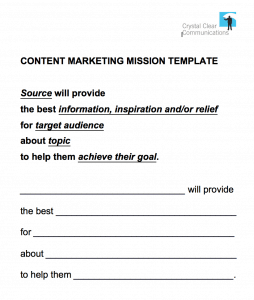
4 ideas to help you eliminate unnecessary marketing work
How a clear mission, strategy and message save you time
Company leaders expect more and more from marketing. They want more of a business partner, more sales and revenue, more growth.
For marketing, that means more and more work.
If you face this dilemma, take a step back. Ask if the marketing team is wasting time by doing unnecessary work.
How can you make unnecessary work disappear to free up time for critical tasks?
Smart marketing leaders build a strategic foundation that cuts out busywork. Here are 4 ideas that foresighted leaders put into practice:
1. Clarify marketing’s mission
State the purpose of marketing clearly, in a way that fits the needs of your industry, company and department.
What exactly does marketing provide that’s of value to customers (internal and external), who do you provide it to, on which topics, with what outcome in mind?
When you make the marketing team’s mission crystal-clear, it’s easier to align marketing with the business. Here’s a template to help you state your mission.

2. Co-create a shared marketing strategy on one page
Gather executives, R&D, product management, marketing and sales face to face in a workshop. Hammer out and win agreement on:
- Company objectives: 3 key things the company must accomplish in the year ahead.
- Company goals: 3 quantitative measures to track company progress on objectives.
- Marketing strategies: 3 key marketing actions to help the company meet objectives.
- Marketing metrics: 3 quantitative measures to track marketing progress on strategies.

When you win agreement with your stakeholders up front, you can set a solid strategy for the year ahead. Your one-page strategy:
- Makes clear to the marketing team exactly what it must accomplish.
- Shows how marketing activities align with the needs of the business.
- Heads off the ever-present temptation to debate each marketing tactic over and over.
Boil down your strategy to one page, so you can hold executives’ attention long enough to gain their input.
Once your strategy is in place, keep it up to date. Revisit it quarterly and revise it as the needs of the business change.
3. Teach everyone to sing the same song
Most companies can’t tell a story. They sound like the Tower of Babel.
Why? Because each executive and each department tells a different story in a different language.
To buyers and customers, all those conflicting stories and languages do not move them to do business with your company.
To address the problem of conflicting messages, convene a message workshop. Include the key decision-makers — executives, R&D, product management, marketing and sales.

Hammer out a unified message for your company. Capture it on one page with a Message Map. A facilitator can help you speed this process.
Make sure everyone who communicates with customers knows how to tell your company’s story. Help them understand why it’s the right message for the company to use.
Train your team to use your company’s Message Map so that everyone who talks to buyers and customers can deliver the same message consistently.
Consistency is crucial. Consistent messages win a special place in your customers’ memories, specifically their place cells. That’s where messages stick.
With a Message Map, you enable the whole company to sing from the same songbook. The company sings with one mighty voice, as one choir.
Hallelujah!
4. Stop unnecessary reports
It’s tempting for each marketing function to generate a separate report to validate each activity. The problem is that status reports start to take on a life of their own and become a waste of time.
True story: When I joined a Fortune 50 company as a trade show manager, our department generated a monthly trade show report for executives, sales and others.
Preparing the report was a cumbersome, manual, time-consuming project. In fact, it took up so much time that it detracted from the more important work of running shows, following up inquiries, and generating marketing-qualified leads.
In my first few weeks, my PC hard drive crashed and lost all the trade show data that my predecessor had created. All the reports and all the data disappeared.
Yikes! I pulled out my hair.
The next day, I decided to stop generating a monthly trade show report and put that time into managing inquiries instead.
I never asked for permission to stop generating the report. I decided that if someone complained, I’d seek forgiveness – using my license as a newbie to plead ignorance.
A month later, a quarter later, a year later, no one ever asked for the monthly report.
What we didn’t know about the monthly trade show report was that no one cared. No one valued it. No one made decisions based on it.
The monthly trade show report was just a task marketing thought it needed to deliver.
Many companies require each marketing function to do its own status report. So, at the end of the month, a marketing VP may get 6 or 10 reports from each separate marketing function. Even with all those reports, no coherent picture emerges that can enable strategic decision-making.
Marketing runs better when you put all your analytics together to create a unified dashboard. A monthly dashboard captures the bigger picture and addresses these key questions:
- What’s working in marketing?
- Why are the trends up or down? What are our hypotheses?
- Do our marketing activities fit together or are they working at cross-purposes?
- Which resources could we add to make marketing work even better?
- Which unnecessary work could marketing stop doing?
- How could we reinvest freed-up time to advance marketing strategies?
- How competitive is our marketing? How does it stack up compared with others?
Don’t waste your time!

These four ideas can save you and your team a tremendous amount of time during the year.
By using these four ideas, you also can escape endless approval processes. Having an agreed mission, strategy and message is like having a get-out-of-jail-free card. It’s easy to escape approval hell.
Win agreement up front on your marketing mission, strategy and message. Skip the unnecessary reports. And focus your team’s energy on advancing the power of marketing.
Enough said!
Related Posts
Marketers, plant content trees that bear fruit
What can marketers learn from gardeners in spring? Like gardening, content marketing is a long slow game. Spring is when gardeners plant trees. Now is a...
Top 100 Content Marketing Question: What are the must-haves when building a content marketing strategy from scratch?
To build a content marketing strategy from scratch, get internal buy-in. How? Here’s the short answer: Inside the company, build buy-in by collaborating with...
Top 100 Content Marketing Question: How can I leverage existing content in my content marketing strategy?
How can I leverage existing content in my content marketing strategy? When you already have good content, do you always need to create more?...
Free Book! High Conflict – How To Communicate with People Who Hold Opposite Views
Do you find yourself avoiding people who hold an opposing political view, or self-censoring your words to avoid starting a fight? Civil discourse has...





